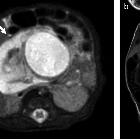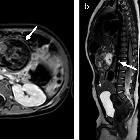Keimzelltumor des Retroperitoneums



Keimzelltumor des Retroperitoneums
Keimzelltumor Radiopaedia • CC-by-nc-sa 3.0 • de
Germ cell tumors are found widely throughout the body and encompass a wide range of individual tumors.
This article does not deal with any specific body locations. For detailed discussion please refer the articles listed at the end of this page.
Pathology
Germ cell tumors arise from ectopic pluripotent stem cells that failed to migrate from yolk endoderm to the gonad. Because they arise from primitive cells, they have variable neoplastic potential and variable degrees of differentiation into a variety of tissues.
Generally, cystic lesions tend to be benign whereas solid lesions tend to be malignant however the final diagnosis is made histologically.
Germ cell tumors are classified by their histology regardless of their location in the body . Although there are many ways of dividing these tumors, a widely used approach is to divide them into seminoma and non-seminomatous tumors.
See: classification of germ cell tumors
- seminoma
- non-seminomatous germ cell tumors (NSGCT)
- embryonal cell carcinoma
- choriocarcinoma
- yolk sac tumor
- teratoma
- mixed germ cell tumor
Additionally a number of other entities not usually included under the heading of germ cell tumor can be included for completeness, as they share many similarities. They include:
- epidermoid cyst: ectoderm only with no epidermal appendages
- dermoid cyst: ectoderm only, but with epidermal appendages
- fetus in fetu / fetiform teratoma
- struma ovarii tumor
Benign (grade 0) tumors have a risk of malignancy despite being indolent initially and require close clinical, serological, and radiological follow-up . There is also a low incidence of malignant transformation of somatic cells (i.e. non germ cell) within these tumors e.g. carcinoma, sarcoma, leukemia .
Siehe auch:

 Assoziationen und Differentialdiagnosen zu Keimzelltumor des Retroperitoneums:
Assoziationen und Differentialdiagnosen zu Keimzelltumor des Retroperitoneums:
